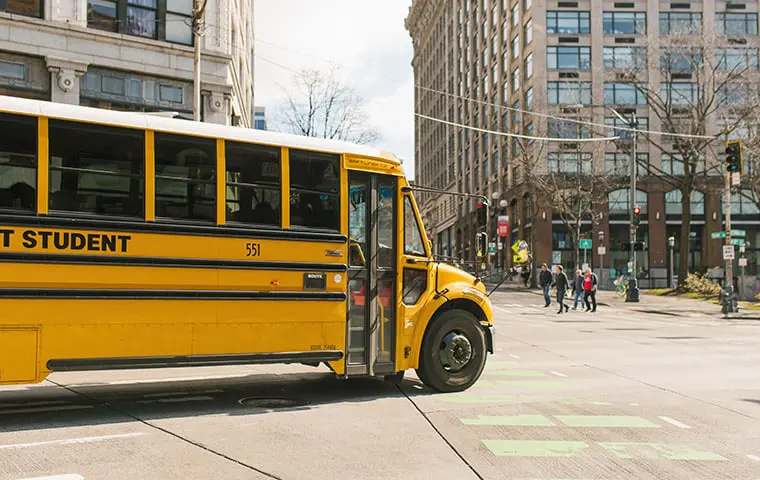In a detailed report, the National Association for Pupil Transportation states that "school bus carriers operate the largest mass transportation fleet in the United States. Each day, 480,000 yellow school buses travel the nation’s roads… [the United States’] school bus fleet is 2.5 times the size of all other forms of mass transportation combined."
According to the American School Bus Council, bus fleets in the United States account for almost six billion miles travelled every year. All of this driving can be expensive. School bus fleet management is the single largest expenditure among school districts in the United States.
Operating a school bus fleet can be costly. On average school buses cost around $100,000 to acquire and have a short lifespan of around 12 years. Operating each school bus route costs school districts $37,000 a year, on average. On top of this, districts generally spend around $50,000 a year on school bus fleet maintenance.
If you are looking for ways to cut down on costs and make improvements to your school bus fleet you’ve come to the right place. In this article we will outline seven easy ways to optimize any school bus fleet.
7 School Bus Fleet Management Tips
1. Improve Route Planning
Inefficient route planning hurts school bus fleets. A school bus will travel an average of 12,000 miles per year. Saving a fraction of those miles every day could greatly reduce fuel costs over the course of a year. In addition, covering less miles reduces maintenance costs for your vehicles and extends their lifespan. Look for ways to efficiently route your school bus fleet.
2. Utilize Telematics and GPS Data
Being able to track your school bus fleet is an integral feature for school bus fleet management. It improves the safety of your fleet. It also allows you to update parents and school administrators in the event of issues or delays.
One way to track your school bus fleet vehicles is by integrating your telematics hardware with your management software. Telematic integration lets you track and view vehicle location as well as view odometer readings and diagnostic trouble codes (DTC). GPS and telematic technology allow managers to gather data to gain greater insights into driver behavior. It can also be used to improve route planning.
3. Prioritize School Bus Fleet Maintenance
Operating expenses for school bus fleets are very high. Many large districts struggle to keep ahead of required maintenance for school bus fleets. It’s an incredible logistical challenge to stay on top of school bus fleet maintenance but it must be done.
School bus fleet managers would be wise to utilize fleet tracking software to improve the maintenance process. It can help create better workflows for transportation managers. Fleet tracking software can also be set to implement alerts when routine maintenance should be performed (rotating tires, changing the vehicles, oil, or having an inspection done etc.).
Many fleet managers find it useful to implement a preventative maintenance schedule in order to keep buses on the road and ready to pick up and drop off students. Preventative maintenance schedules let fleets stay on top of routine servicing and helps maximize the lifespan of their vehicles.
School bus fleet maintenance software makes this easy and allows managers to set reminders based on time and mile intervals. It also lets you create mobile work orders in order to schedule, plan, and execute maintenance tasks. School bus fleet maintenance software helps make sure your buses get the maintenance they need to reliably transport students.
4. Reduce Idle Time
Idling might not seem like much of an issue, but it's expensive. On average, school districts waste over $64,000 per year on idling (for a 100-bus fleet). One of the easiest ways you can optimize your fleet is by cutting down on your fleet’s idle time. Make your drivers aware of the cost of idling. Reminding drivers of the environmental impact of idling can shift their frame of mind and get them on board.
5. Stay Up-to-Date on School Bus Fleet News
Top school bus fleet managers stay up-to-date on school bus fleet news. It's an incredibly easy way to optimize your fleet. Keeping up with the latest news in school bus fleets will keep you ahead of the curve. School bus fleet management often relies on fleet news to discover the latest technologies and trends in the industry. Staying up-to-date with industry news means you’ll be able to understand and implement these changes faster.
6. Attend School Bus Fleet Forums
One of the best ways to optimize your fleet is by educating yourself and your team. Attending industry conferences and school bus fleet forums will keep you sharp and ahead of trends in the industry. You’ll be able to converse with your school bus fleet peers and gain insights you wouldn’t find sitting behind a desk. Check out events going on in your area and sign up to attend!
7. Implement a Transport Manager Position
Many schools attempt to have a teacher pull double duty as transport coordinator in order to lower expenses. Although this may save money up front, it will increase stress and risk down the line.
A transport manager is responsible for the routes the bus takes, the drivers’ rotation schedule, and the students’ database. Putting one person in charge of student transportation provides parents with a point of contact and also gives the school someone to hold accountable in case of incidents or delays.
School bus fleets are expensive to operate. Optimizing a fleet can help cut down on expenses and improve its service. Check out all the amazing benefits that Azuga Fleet™ can offer your fleet.








